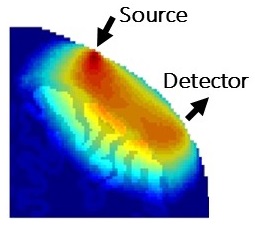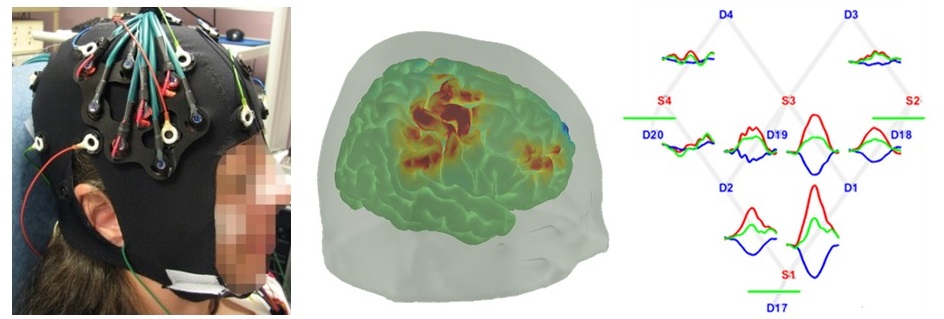fNIRS
Functional Near-Infrared Spectroscopy (fNIRS) is a non-invasive, portable method employing near-infrared light propagating diffusely through the scalp and brain, for functional monitoring and imaging of human brain hemodynamics.
This neuroimaging modality is particularly suite d for populations and studies where other imaging options are limited, such as infants, children, and volunteers/patients interacting freely with their environment. fNIRS has found a wide range of applications to study normal and pathological brain physiology, including perception and cognition, motor control, psychiatric conditions (depression, schizophrenia), and behavioral and cognitive development in infants and children.
d for populations and studies where other imaging options are limited, such as infants, children, and volunteers/patients interacting freely with their environment. fNIRS has found a wide range of applications to study normal and pathological brain physiology, including perception and cognition, motor control, psychiatric conditions (depression, schizophrenia), and behavioral and cognitive development in infants and children.
More background information on NIRS can be found on the Scholarpedia webpage. A recent special issue of NeuroImage provides a thorough review of the field, as well as publications on state-of-the-art applications. The introduction to the special issue can be found here. The Society for Functional Near Infrared Spectroscopy runs a conference every two years and hosts a Facebook page from which one can connect with the international fNIRS community.

Learn more about our fNIRS resources, training opportunities and also ongoing projects.
Github Code:
Homer3 and AtlasViewer on Github.
Please contact Meryem Yücel if you need further assistance.
Ongoing Projects:
NEUROSCIENCE IN EVERYDAY WORLD
fNIRS SIGNAL PROCESSING
- fNIRS noise regression with a multimodal extension of the General Linear Model using temporally embedded Canonical Correlation Analysis
- fNIRS Single Trial Analysis and Classification using the General Linear Model
- HOMER3 and AtlasViewer
- Contribution of Speckle Noise in Near Infrared Spectroscopy Measurements
fNIRS Acquisition
fNIRS IN CLINICAL AND NEUROSCIENCE RESEARCH
- fNIRS Inclusion Study
- Mirror Neuron System in Autism
- fNIRS-based control of robotic exosuits
- Assessing brain correlates of language impairment in Stroke patients
- Examine the effects of a rehabilitation program on patients with Parkinson’s disease
- Auditory selective attention
- Visual and Auditory Attentional Network
- Early detection of Alzheimer’s Disease
NON-BU COLLABORATIONS
